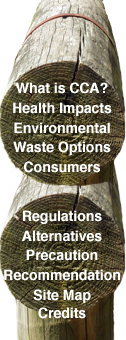Health Impacts
Working with CCA-Treated Timber
![]() Building
Workers
Building
Workers
![]() International
Research
International
Research
![]() Government
Advice
Government
Advice
![]() Material
Safety Data Sheets
Material
Safety Data Sheets
![]() References
References
Building Workers
The Australian Workers’ Union (AWU) took a precautionary approach in October 2004 and banned ‘certain methods of usage of construction materials treated with copper chrome arsenate’ due to the material’s capability for releasing arsenic and ‘therefore exposing workers to unacceptable risks’. The AWU requires workers to assess the risk of working with the CCA-treated timber before they work with it, and if high and continued exposure cannot be avoided, these tasks ‘must be banned outright’. The AWU requires any site using CCA-treated material to appoint a CCA Officer to supervise all handling of CCA-treated timber. Unless these requirements are followed, the AWU warned they would place a ban on handling all CCA-treated timber (AWU, 2004).
The preventative measures taken by the AWU are not without supportive evidence. The US EPA's Incident Data System contains reports of injury from CCA-treated timber, listing incidents of ‘itching, burning, rashes, neurological symptoms, and breathing problems after handling lumber; damage to nerves in feet and legs from CCA sawdust and fumes from construction; chronic rash; eye swelling from dust; headache, nausea, shakiness, and thirst from cutting timber; rashes on arms from dust; nausea and headache from drilling timber’ (cited by Feldman, 2002).
The Scientific Committee on Toxicity, Ecotoxicity and the Environment (CSTEE) of the European Commission noted ‘a number of studies… have reported urinary arsenic concentrations to be substantially elevated (up to ca. tenfold as compared to controls) in wood impregnation workers’ (CSTEE, 1998). Such information did not go unnoticed by the APVMA review, which made a specific recommendation for ‘worker exposure data … required to address the identified concerns for worker safety, for both dermal and inhalation for both arsenic and chromium’ (APVMA, 2003, p.10).
The Australian National Occupational Health and Safety Commission 1987 Code of Practice (later replaced by AS5605 – see Section on Australian standards) stated that ‘material safety datasheets for CCA-treated timber should include a warning on precautions to be taken when machining internally wet timber. These precautions should include the use of respirators with particulate filters in dust-producing operations, and gauntlet gloves.’
The US EPA advises:
Saw, sand and machine CCA-treated wood outdoors. Wear a dust mask, goggles, and gloves. Clean up all sawdust, scraps, and other construction debris thoroughly… Do not compost or mulch sawdust or remnants… Do not burn CCA-treated wood, as toxic chemicals may be released as part of the smoke and ashes. After working with the wood, wash all exposed areas of your body, especially the hands, thoroughly with soap and water before eating, drinking, toileting, or using tobacco products. Wash your work clothes separately from other household clothing before wearing them again. (Office of Pesticide Programs, 2002)
Even the timber treatment industry recognises the risks associated with CCA-treated timber. The Material Safety Data Sheet for PineSolutions’ CCA-treated plantation pine, states ‘WARNING: This substance has been classified by the IARC as Group 1: Carcinogenic to humans’. Furthermore, it states that ‘Wood dusts produce dermatitis and an increased risk of upper respiratory disease. Epidemiological studies in furniture workers show an increased risk of lung, tongue, pharynx and nasal cancer. An excess risk of leukaemia amongst millwrights probably is associated with exposure to various components used in wood preservation’ (PineSolutions, 2000).
Auspine’s Material Safety Data Sheet recommends to ‘avoid generating dust. Wood dust is classified as carcinogenic to humans … adverse health effects are usually associated with long term exposure to high dust levels’ (Auspine, 2004). Koppers Arch’s Safety sheet goes further, stating:
Repeated inhalation of dust from this product may cause nasal and other respiratory cancers. Some compounds of arsenic are associated with an increased risk of lung cancer. Some chromium compounds have been associated with an increased risk of nasal cancer. Wood dust is associated with an increased risk of nasal cancer. Exposure to wood dust in some susceptible people may result in respiratory and skin sensitisation leading to asthma and dermatitis respectively (Koppers Arch, 2002).
However renovation and do-it-yourself television programmes seldom demonstrate these safety practices, so that home handy-people are misled into thinking no precautions are necessary when they saw and sand CCA-treated timber, and as will be seen in the survey of retailers in section 5, they do not receive any information to the contrary from timber retailers where they buy the timber.
References:
AWU (2004), National Hazard Alert and Ban: Usage of Copper Chrome Arsenate (CCA) treated timber, Australian Workers’ Union, 15 September.
APVMA (2003), The Reconsideration Of Registrations Of Arsenic Timber Treatment Products (CCA And Arsenic Trioxide) And Their Associated Labels (Technical Report), Australian Pesticides And Veterinary Medicines Authority, Canberra. (pdf - 4.5MB)
Auspine (2004), ChemAlert: CCA Treated Plantation Softwood’, Material Safety Data Sheet, http://www.auspine.com.au (accessed 1/11/04).
CSTEE (Scientific Committee on Toxicity, Ecotoxicity and the Environment) (1998), ‘Opinion on the Report by WS Atkins International Ltd (Vol. B) "Assessment of the Risks to Health and to the Environment of Arsenic in Wood Preservatives and of the Effects of Further Restrictions on Its Marketing and Use" Expressed at the 5th CSTEE Plenary Meeting.’ Brussels: European Commission (EC). 15 September.
Feldman, Jay (2002), ‘Letter to US EPA: Beyond Pesticides Comments on CCA-Treated Wood’, Beyond Pesticides website, March 22, http://www.beyondpesticides.org/wood/alerts/CCA_comments.htm (accessed 6/12/04)
Koppers Arch (2002), Tanalith CCA timber treatment- Materials Safety Data Sheet, Koppers Arch, Sydney.
Office of Pesticide Programs (2002). ‘Questions & Answers: What You Need to Know About Wood Pressure Treated with Chromated Copper Arsenate (CCA).’ US Environmental Protection Agency (EPA). 12 February. http://www.epa.gov/oppad001/reregistration/cca/cca_qa.htm.
PineSolutions (2000), ‘CCA Treated Plantation Pine’, Material Safety Data Sheet, http://www.pinesolutions.com.au/products/MSDS/downloads/cca_treatedpine.pdf (accessed 1/11/04).


